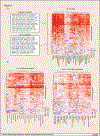T Cell-Inflamed versus Non-T Cell-Inflamed Tumors: A Conceptual Framework for Cancer Immunotherapy Drug Development and Combination Therapy Selection
- PMID: 30181337
- PMCID: PMC6145135
- DOI: 10.1158/2326-6066.CIR-18-0277
T Cell-Inflamed versus Non-T Cell-Inflamed Tumors: A Conceptual Framework for Cancer Immunotherapy Drug Development and Combination Therapy Selection
Abstract
Immunotherapies such as checkpoint-blocking antibodies and adoptive cell transfer are emerging as treatments for a growing number of cancers. Despite clinical activity of immunotherapies across a range of cancer types, the majority of patients fail to respond to these treatments and resistance mechanisms remain incompletely defined. Responses to immunotherapy preferentially occur in tumors with a preexisting antitumor T-cell response that can most robustly be measured via expression of dendritic cell and CD8+ T cell-associated genes. The tumor subset with high expression of this signature has been described as the T cell-"inflamed" phenotype. Segregating tumors by expression of the inflamed signature may help predict immunotherapy responsiveness. Understanding mechanisms of resistance in both the T cell-inflamed and noninflamed subsets of tumors will be critical in overcoming treatment failure and expanding the proportion of patients responding to current immunotherapies. To maximize the impact of immunotherapy drug development, pretreatment stratification of targets associated with either the T cell-inflamed or noninflamed tumor microenvironment should be employed. Similarly, biomarkers predictive of responsiveness to specific immunomodulatory therapies should guide therapy selection in a growing landscape of treatment options. Combination strategies may ultimately require converting non-T cell-inflamed tumors into T cell-inflamed tumors as a means to sensitize tumors to therapies dependent on T-cell killing. Cancer Immunol Res; 6(9); 990-1000. ©2018 AACR.
©2018 American Association for Cancer Research.
Conflict of interest statement
Figures


References
-
- Azimi F, Scolyer RA, Rumcheva P, Moncrieff M, Murali R, McCarthy SW, et al. Tumor-infiltrating lymphocyte grade is an independent predictor of sentinel lymph node status and survival in patients with cutaneous melanoma. Journal of clinical oncology : official journal of the American Society of Clinical Oncology 2012;30(21):2678–83 doi 10.1200/JCO.2011.37.8539. - DOI - PubMed
-
- Mahmoud SM, Paish EC, Powe DG, Macmillan RD, Grainge MJ, Lee AH, et al. Tumor-infiltrating CD8+ lymphocytes predict clinical outcome in breast cancer. Journal of clinical oncology : official journal of the American Society of Clinical Oncology 2011;29(15):1949–55 doi 10.1200/JCO.2010.30.5037. - DOI - PubMed
Publication types
MeSH terms
Substances
Grants and funding
LinkOut - more resources
Full Text Sources
Other Literature Sources
Research Materials

